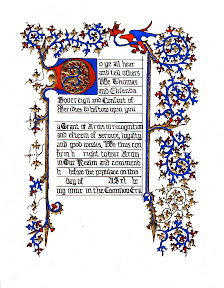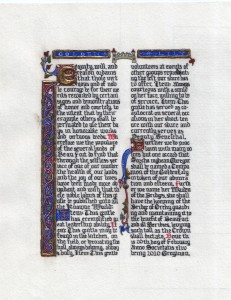Not Holy but still Cow! Or more precisely, cow skin. Vellum or parchment depending on who you ask.
Back in April, I had done about 8 weekends in a row that I was either at an event or otherwise not at home. It was definitely time for a break. I was not going to another event until Lusty Month of May. I heard that Bryn Madoc was hosting an Iron Scribe at their Dreamstone event. It sounded so cool but I really needed a break so I was not going to go. I needed a break!
Then I heard that the prize for the Iron Scribe competition was going to be almost a full hide of vellum. A full hide of vellum!!!! I decided I could take a break the next weekend. 🙂
The rules for the contest were you had to start with a blank sheet of paper and end with an illuminated piece that was at least 5″ x 5″. The contest started at 10am and ended at 3pm.
I am a wee bit of a competitive person (wee b
eing probably a bit to the excessive side) and I really, really, really wanted the vellum. I did do a bit of pre-prep work: found a source piece, enlarged a photocopy to the proper size to get an 8″x10″ (5″x7″ illumination area) scroll, and made certain the text of a GOA would fit in the space.
The source piece is a late 14th or early 15th century French (Paris) Book of Hours. The original was 215 x 155 mm (text 110 x 72 mm) on Parchment. Page 74 of the book “Western European Illuminated Manuscripts.”
The design was traced on the paper (Pergamenata) using a light box and 01 technical pen. Calligraphy was done with .75 Brause nib using iron gall ink. Calligraphy style was textura quadrata.
I used gesso that I started re-hydrating the night before. The gesso is from the original batch I made years ago. (Ingredients: slaked plaster, hide glue, honey, Armenian bole, water) It turns out there was about twice as much gold to put on as I had originally thought when I looked at the picture. The gilding process took about an hour and a half longer than I had originally planned for.
I used gouache for the illumination. Holbein light ultramarine and alizarin crimson for the blue and red. The painting was finished at 4 hours and 57 minutes. Because of the extra time spent on the gold, I was not able to get the white work on during the contest.

This is what was done for the judging
I put the white work on during the 4th Wednesday scribal night meeting and have since turned the final product in to Their Majesties. Total time on the scroll – approximately 8 hours.

The final product

